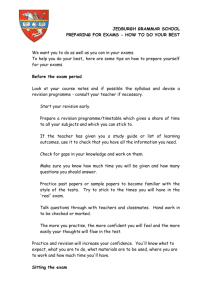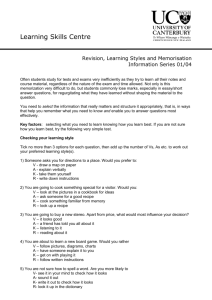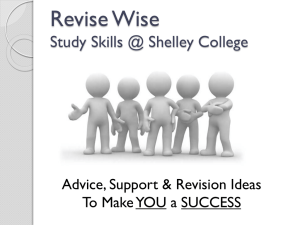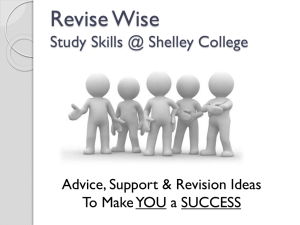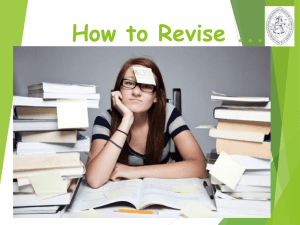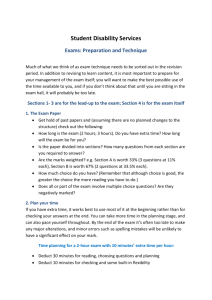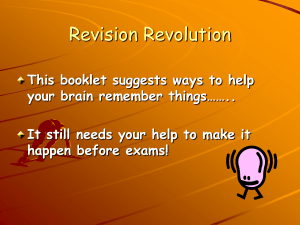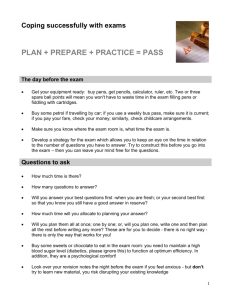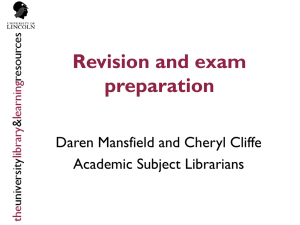Exams & Revision
advertisement
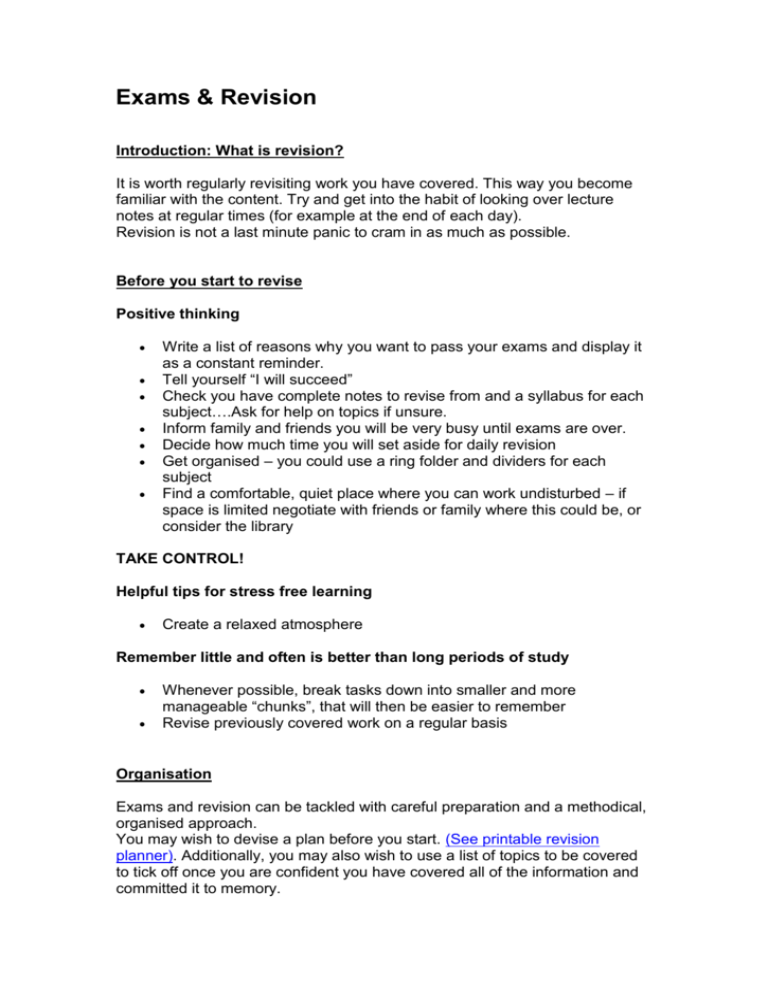
Exams & Revision Introduction: What is revision? It is worth regularly revisiting work you have covered. This way you become familiar with the content. Try and get into the habit of looking over lecture notes at regular times (for example at the end of each day). Revision is not a last minute panic to cram in as much as possible. Before you start to revise Positive thinking Write a list of reasons why you want to pass your exams and display it as a constant reminder. Tell yourself “I will succeed” Check you have complete notes to revise from and a syllabus for each subject….Ask for help on topics if unsure. Inform family and friends you will be very busy until exams are over. Decide how much time you will set aside for daily revision Get organised – you could use a ring folder and dividers for each subject Find a comfortable, quiet place where you can work undisturbed – if space is limited negotiate with friends or family where this could be, or consider the library TAKE CONTROL! Helpful tips for stress free learning Create a relaxed atmosphere Remember little and often is better than long periods of study Whenever possible, break tasks down into smaller and more manageable “chunks”, that will then be easier to remember Revise previously covered work on a regular basis Organisation Exams and revision can be tackled with careful preparation and a methodical, organised approach. You may wish to devise a plan before you start. (See printable revision planner). Additionally, you may also wish to use a list of topics to be covered to tick off once you are confident you have covered all of the information and committed it to memory. Revision and learning style Exams do place emphasis on memory and remembering information (often in sequence). In order to enhance your memory, you can use multisensory approaches (that is methods that use a variety of different senses – sight, movement, sound and so on). Some of the methods for revision suggested below involve appealing to the different senses, not just reading and writing. It may be worth considering a variety of approaches and see which work best for you. Here are some suggestions for different learning styles which relate to the VARK learning styles (Visual, Aural, Reading, Kinaesthetic). Visual – seeing pictures, diagrams, using images and visuals Mindmapping Putting posters up on walls Drawing pictures and diagrams alongside notes Using colour coding and highlighting Watching videos to support topics 3D models on the internet Aural – listening to things, talking, discussing Taping notes and playing it back Discussing revision with friends Reading notes aloud Asking questions of yourself Summarising topics aloud Devise quizzes with a friend and test each other Reading – written and printed information Written notes reading information Writing information out in different formats Practice essay writing Kinaesthetic – hands on, acting out, touching and doing Putting posters up on walls Watching videos to support topics Doing something – make a model or scene, for example use figures to renact an historic scene Act things out Revision walkthrough – cards laid out on floor in order Making cards and putting in sequence Interactive packages (CD-ROMs, internet) Some suggested approaches to revision Visual approach. Collect all the stuff you want to revise: notes, handouts, essays etc. Divide the stuff into topics. Have large sheets of paper (e.g. A3) ready. If you are a colour person, have a different colour for each topic. Read through a topic. When you come to a bit you enjoyed, put a phrase or symbol on one of the large sheets of paper. (Colour people: use (say) dark blue felt-tip on light blue paper.) If you are a mind-map person, draw shapes round the phrases and/or combine them into a spider plan. Every now and then, look away from your notes and talk through what you have just read, out loud. If possible, talk about it with a friend. Stick the charts on the wall in odd places, such as sideways in the loo. When you are out, practise walking though your house in your head and seeing the charts. Smell and taste approach. In the exam, you can have a small tube of sweets on the table. However , this does not have to contain actual sweets -it could be bits of crisps, dry toast, bacon etc. As you revise a topic, nibble a strong-flavoured food such as burnt toast, which can easily be put into a' sweets' tube. Eat that food only when reading about the same topic. Take tubes of bits of your revision foods into the exam. If you choose to write about that topic in the exam, take out the tube and suck/nibble the food while thinking about it. (Do not have many topics linked with foods, because you have to remember which is which. It is best to practise this before the actual exam, to see if it works for you. ) The same applies to perfumes, which you can sniff while revising and have on tissues/small handkerchiefs in the exam. The senses of smell and taste are very strong memory triggers. Sound approach. This works best for lists, formulae etc., although the points from a brainstorm can be listed if you like. Speak the list aloud rhythmically, and see if the rhythm reminds you of a well-known song. (It's good if it's a song you've got a karaoke tape for.) Fit the list to the tune. Add little words like 'and' if necessary. Sing it regularly. If possible, record yourself singing it and play it back in the car etc. Play a drum/tambourine (or armchair arm) while singing. As with smell and taste, do not do this with too many lists. Movement approach (‘walk through’) This works particularly well for information that needs to be learned in sequence. Write out basic information to be learned onto index cards (these can be bought from stationery shops) or small pieces of paper (roughly ¼ size A4) If you are a colour person, try colour coding them If you are an image person, try putting images or doodles to ‘jog’ your memory Lay them out on the floor in sequence, and as you come to each sheet, say the information aloud. You may also wish to place the cards in different rooms of the house. The act of movement, along with visual cues, may make information easier to remember. Use past papers. Take a past paper (preferably unread) to a silent area of the library. Put your watch on the table. Take out the paper, and give yourself tell minutes to read it several times and choose which questions you would answer. Then give yourself another set time to note just the bullet points of what you would include in one of the answers (or do a 'brainstorm' spider). Then go away and do something else. If you have enough past papers, slowly work up to being able to prepare. Note bullet points (or brainstorm) for three or four essays one after the other, within a time limit that suits you. If you are a brainstorm person, practise forcing the points into an order. Other devices that you could use include: Sound recording devices – try recording yourself relating information to be remembered. This could be converted to be played back whilst you are doing other things, for example washing up, or travelling, to maximise the time spent revising. Revising with friends – discussing topics can help to clarify issues n your own mind and you could try testing one another on topics. Before the exam Find out the basic information about the exams, for example: When and where they are to be held How they will be assessed The timing of the exams (do you have extra time?) Find out about the exam instructions, for example: What you are allowed to take with you Practice using past paper – this can help you get used to timings In the exam. Ignore other people who start writing straight away. Read the whole paper several times. Choose your questions. Note bullet points (or do a brainstorm) for each question you are going to answer. This allows your memory to recall stuff while you are writing. Then you can relax a bit because you have made a start on all the questions. Now work out the remaining time, and divide it by the number of questions, leaving a bit of time for proof-reading. As you start a question, note down the time you want to finish it. Stress What causes stress? Pressure High expectations Prospect of failure Poor lifestyle, for example poor diet, lack of sleep, lack of exercise Poor time management How can you cope with stress? Be positive – focus on what you can achieve. Set targets, reward yourself Get help from others – teachers, parents, friends Take control Plan, organise and manage your time Learn to switch off and relax Consider your lifestyle – diet, sleep and exercise Be prepared to put some of your social life on hold How you can reduce stress? You body and brain will function more efficiently if it has: Healthy food Eat regular meals and use this time to calm down and to relax. Some food can increase your anxiety levels especially sugar in foods, tea or coffee. Make a note of foods you feel make you feel this way and avoid having them. Sleep The most valuable hours of sleep are those between 8pm and 12pm. Just try until your exams are finished to have earlier nights. You could video record a programme you would like to see. Water We should all be drinking approximately 2 litres of water a day. Try to at least increase your water intake as it has a positive effect on brain function. Relaxation Listening to music, playing a musical instrument, yoga, even day-dreaming – find a way to relax. Build relaxation into your regular breaks. Breathing Learning how to control your breathing helps to reduce stress and can be very effective in controlling panic during exams – take deep breaths through your mouth and breathe out slowly through your nose, focusing on the breath as you exhale. Regular exercise Try to find a way of taking regular exercise doing some every day. If you raise your heartbeat for just 15 minutes a day your body and brain will function more efficiently. Printable Revision Planner
